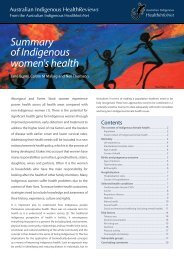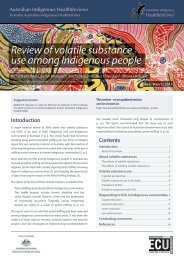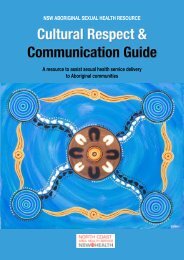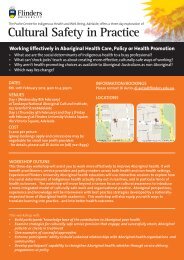hearing loss and the criminal justice system - Australian Indigenous ...
hearing loss and the criminal justice system - Australian Indigenous ...
hearing loss and the criminal justice system - Australian Indigenous ...
You also want an ePaper? Increase the reach of your titles
YUMPU automatically turns print PDFs into web optimized ePapers that Google loves.
elationships with teachers 6 . A 2008 study found that <strong>the</strong> prevalence of ear diseasewas almost twice as high amongst Aboriginal people who had completed Year 9 <strong>and</strong>below, compared to Aboriginal people aged 18-34 who had completed Year 12. 7There is also evidence to suggest this decreased educational attainment correlates withan increased likelihood of involvement in <strong>criminal</strong> activity. Aboriginal people whohave completed Year 9 or below are more than 3 times more likely to be imprisonedthan Aboriginal people who complete Year 12. And, Aboriginal people who haveonly completed Year 9 or below are also more than twice as likely to have beencharged with an offence than Aboriginal people who have completed Year 12 8 .1.3 Hearing Impairment, Self Concept <strong>and</strong> Social FunctioningHearing impairments can have a significant impact on self-concept <strong>and</strong> identity. Thisin turn may increase <strong>the</strong> likelihood of involvement in <strong>criminal</strong> activity. It isconsidered that a <strong>hearing</strong> <strong>loss</strong> of more than 20 dB may have significant negativesocial consequences, <strong>and</strong> that a <strong>loss</strong> of 35 dB almost certainly will 9 .Limaye found that deafness often leads to poor communication skills, which leavesadolescents feeling frustrated 10 . This feeling can lead to ‘emotional <strong>and</strong> behaviouralproblems such as social withdrawal, short temper tantrums, anger towards <strong>the</strong>mselves<strong>and</strong> <strong>the</strong>ir parents’ 11 . It is noteworthy that MacPherson found that <strong>the</strong> best identifier of<strong>hearing</strong> <strong>loss</strong> among urban Aboriginal students was social problems with <strong>the</strong>ir peers 12 .The link between social <strong>and</strong> psychological problems caused by <strong>hearing</strong> disabilities<strong>and</strong> <strong>criminal</strong> activity was made in <strong>the</strong> Royal Commission into Aboriginal Deaths inCustody. It was <strong>the</strong>re noted in relation to <strong>the</strong> case of Graham Walley that <strong>hearing</strong>impairment:“would have added to his problems because it has a compounding effect … ofreducing self-esteem <strong>and</strong> seeing himself negatively … certainly it would havebeen a factor in poor behaviour” 13 .It is also significant that in one large remote Aboriginal community where <strong>hearing</strong>tests were conducted, it was noted that many petrol sniffers in <strong>the</strong> community wereyouths who had previously been identified as having chronic <strong>hearing</strong> <strong>loss</strong> 14 .6 <strong>Australian</strong> <strong>Indigenous</strong> Health Info Net (2006) Review of ear health <strong>and</strong> <strong>hearing</strong>,par 2. athttp://www.healthinfonet.ecu.edu.au/o<strong>the</strong>r-health-conditions/ear/reviews/our-review (viewed 8February, 2010)7 <strong>Australian</strong> Bureau of Statistics <strong>and</strong> <strong>Australian</strong> Institute of Health <strong>and</strong> Welfare (2008) The Health <strong>and</strong>Welfare of Australia’s Aboriginal <strong>and</strong> Torres Strait Isl<strong>and</strong>er Peoples 2008, ABS Release 4704.0, p 25.8 NSW Bureau of Crime Statistics <strong>and</strong> Research (2006) ‘The economic <strong>and</strong> social factors underpinning<strong>Indigenous</strong> contact with <strong>the</strong> <strong>justice</strong> <strong>system</strong>: Results from <strong>the</strong> 2002 NATSISS survey’, ContemporaryIssues in Crime <strong>and</strong> Justice, 104.9 Above, note 3.10 Limaye, S. (2004) ‘Exploring <strong>the</strong> Impact of Hearing Impairment on Self-Concept’, InternationalJournal for <strong>the</strong> Advancement of Counselling, 26 (4).11 Ibid.12 McPherson, B., Preston, G., Canuto, C, <strong>and</strong> Kimber, L. (1992) ‘Teacher Identification of HearingLoss in Aboriginal Children’, <strong>Australian</strong> Journal of Audiology, 14.13 Royal Commission into Aboriginal Deaths in Custody, National Report, Volume 2, AGPS, Canberra,1991, 16.5.113








